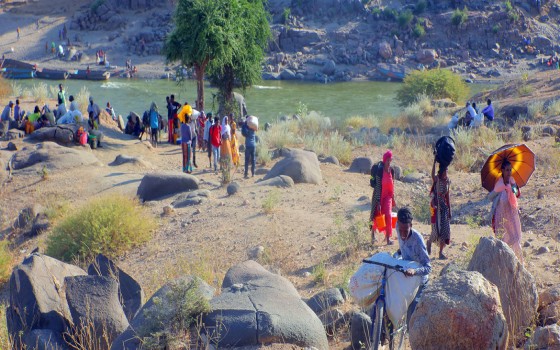
-Today the world population is 8 billion ... Preparation Dr. Abdel Moneim Sedky Professor at the Agricultural Research Center - EGYPT

- Europe and Arabs
- Tuesday , 15 November 2022 21:36 PM GMT
Today (November 15, 2022, when the global population has reached 8 billion), the world is facing one of the biggest challenges of the twenty-first century, which is how to feed 9-10 billion people by 2050. Meeting these needs according to the current patterns of food consumption and production will lead to increased pressure on resources. There are many natural problems that scientists face as a result of population increase, the most important of which is:
. weather changes
Climate change includes not only an increase in average temperatures, but also extreme weather events, a change in the numbers of wildlife and their natural habitats, a rise in sea levels and various forms of impacts. And the emergence of these changes increases with the continual addition of humans to more greenhouse gases to the atmosphere, changing the climate pattern on which all living organisms depend. Many people believe that climate change basically means an increase in temperatures. But the rise in temperature is only the beginning. Since the planet Earth is an integrated system where everything is interconnected and changes in one area can affect changes in all other areas. Climate change will increase floods, droughts, storms and other types of extreme weather by disrupting and shrinking global food supplies over time. More than 10% of the world's population is still undernourished. Food shortages may lead to increased migration across borders and, in some few cases, climate change. Climate increases the production of a few types of food because warmer temperatures, for example, mean greater productivity of those crops, but in general, climate change already harms the largest amount of crops and threatens the loss of agricultural lands due to erosion, desertification and sea level rise. Food crises can develop. on several continents simultaneously and the potential risk of multi-breadbasket failure is increasing. All of these repercussions happen simultaneously.
Food loss
Reducing food loss is essential in an increasingly hungry world where tons of edible food are lost every day. Annual food loss reached 1.3 billion tons, or a third of the total food produced globally, and there are still about 345 million people in the world who face acute food insecurity in 82 countries, which is twice the number of people who were suffering from acute food insecurity before the Corona pandemic. Food loss is an essential factor for achieving food security and the sustainability of food systems in the world. Official estimates indicate that each person in the Near East and North Africa region loses annually the equivalent of 250 kg of food. Food losses are recorded along the food chain from production to consumption, about 68% of the losses during food production, handling, processing and distribution. There is a large loss of food commodities due to poor harvesting methods, lack of cold storage equipment, appropriate means of transportation, poor handling, exposure to heat, sunlight, and poor systems. Marketing and weak policy and regulatory frameworks. Food losses at the consumption stage in the Near East and North Africa region are estimated at 34 percent, mostly in urban areas. A great deal of loss is recorded during religious events, weddings, family gatherings, and in the hospitality sector such as restaurants and hotels.
plastic waste
The oceans are exposed to the danger of plastic waste on the marine environment, which results from the accumulation of plastic bags, food containers, and empty containers at the bottom. With the accumulation of this waste, a large number of marine organisms and fish die as a result of being trapped in plastic waste and the difficulty of getting rid of it, which leads to death over time. She eats plastic bags because she thinks they are jellyfish. About one million plastic water bottles every minute around the world, while the use of single-use plastic bags reaches 5 trillion every year. Plastic materials are used once to end up as waste, and as a result, pollution that is called environmental pollution occurs, which is the accumulation of plastic materials to a very large extent in the environment, which leads to harm to the lives of various living organisms as well as humans. The continuous growth of emissions in the plastics production sector hinders the goal of reaching carbon neutrality. Greenhouse gas emissions from plastics amounted to 1.7 gigatonnes of carbon dioxide equivalent and are expected to reach approximately 6.5 gigatonnes by the year 2050. Plastic accounts for 85% of all marine litter and by 2040 it will almost triple adding 23-37 million metric tons of waste into the ocean annually. This means about 50 kilograms of plastic per meter of coastline, threatening the marine environment from plankton, shellfish, fish and turtles, with the risk of poisoning, behavioral disturbance and suffocation.
The United Nations launched the Sustainable Development Strategy, which is a subsidiary initiative, which is a set of 17 goals developed by the United Nations Organization, and the 17 sustainable development goals were included in the 2030 Agenda for Sustainable Development. They are interconnected and under each goal a group of specific small goals representing a total of 169 very. The sustainable development goals cover a wide range of social and economic development issues (poverty - hunger - health - education - climate change - gender equality - water - sanitation - energy - environment - social justice - and protection of oceans and forests.)
We must support farmers to adopt more productive and sustainable systems that are resilient to droughts, floods and other hazards, with social protection measures such as safety nets and food aid programs targeted at the neediest and most caring.
Preserving natural resources by adopting strategies to modify consumption patterns and modify behaviors to ensure a reduction in the carbon footprint of various human activities to preserve resources for future generations.
• Take the necessary means and measures to preserve the environment
• Commitments by industrialized countries that emit greenhouse gases towards developing countries affected by climate change to improve infrastructure and establish green transformation projects.












No Comments Found